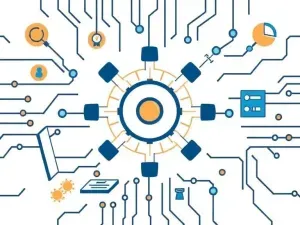Introduction
For decades, businesses made decisions based on intuition, experience, or simple historical data. Today, data science has revolutionized this process, enabling predictive analytics, uncovering hidden patterns, and automating critical decisions. According to a McKinsey study, organizations that adopt data-driven models increase their EBITDA margin by 6-10%.
This article explores how machine learning, big data, and advanced analytical techniques are replacing traditional methods, with real-world examples and success cases.
1. The Fundamentals of Data Science in Business
1.1 What Is Business Data Science?
Data science combines:
- Advanced statistics
- Programming (Python, R, SQL)
- Machine learning (ML)
- Data visualization
Its goal is to extract valuable insights from large volumes of data to make more precise decisions.
1.2 Typical Workflow
# Example pipeline in Python (Pandas + Scikit-learn)
import pandas as pd
from sklearn.model_selection import train_test_split
from sklearn.ensemble import RandomForestClassifier
# Data loading and cleaning
data = pd.read_csv("company_sales.csv")
data = data.dropna()
# Feature engineering
data['month'] = pd.to_datetime(data['date']).dt.month
# Model training
X = data[['month', 'product_id']]
y = data['successful_sale']
X_train, X_test, y_train, y_test = train_test_split(X, y, test_size=0.2)
model = RandomForestClassifier()
model.fit(X_train, y_train)
# Evaluation
accuracy = model.score(X_test, y_test)
2. Real-World Use Cases
2.1 Supply Chain Optimization
Company: A retail giant.
Problem: Inventory waste (20% annual losses).
Solution:
- Time-series models to predict demand.
- Clustering algorithms to identify regional patterns.
Result: 15% reduction in logistics costs.
-- Query to identify low-turnover products
SELECT product_id, SUM(stock) as total_stock
FROM inventory
WHERE date BETWEEN '2022-01-01' AND '2022-12-31'
GROUP BY product_id
HAVING total_stock > 1000;
2.2 Marketing Personalization
Example: Netflix uses real-time recommendations with:
- Collaborative filtering ("users like you watched X").
- Natural language processing (review analysis).
Impact: 35% fewer cancellations due to irrelevant content.
3. Challenges and Solutions
3.1 Common Barriers
- Data quality: 60% of projects fail due to incomplete data.
- Cultural resistance: Executives distrust "opaque" models.
3.2 Key Implementation Strategies
- Start small: Pilot projects with clear KPIs.
- Invest in talent: Data scientists + internal training.
- Essential tools:
- TensorFlow (deep learning).
- Power BI (visualization).
- Apache Spark (large-scale processing).
4. The Future: Explainable AI and Automation
4.1 Interpretable Models (XAI)
# Example of SHAP (model explainability in R)
library(shapviz)
model <- xgboost(data = train, label = y_train)
shap_values <- shapviz(model, X_pred = test)
plot(shap_values, "feature_importance")
4.2 Decision Automation
- NLP chatbots for customer service.
- Financial robots that adjust prices in seconds.
Conclusion
Data science is no longer a competitive "plus" but a requirement for survival. Companies like Amazon, Walmart, and Tesla use it to:
✅ Reduce operational costs.
✅ Anticipate market trends.
✅ Create hyper-personalized experiences.
The shift from intuition to data is irreversible. Is your business ready?
"Data is the new oil, but only if you know how to refine it." — Clive Humby, creator of loyalty programs.






